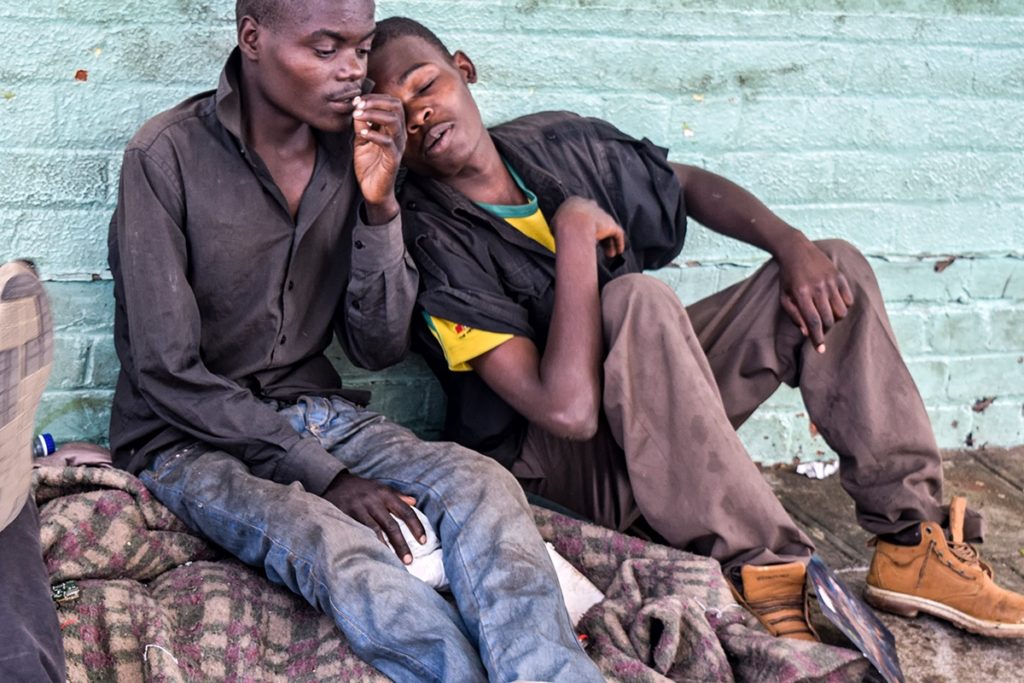IT is do or die on the streets of Zimbabwe as homeless families battle for survival solely depending on begging. Such is the life of 69-year-old Gladys Mugabe, who lives with her disabled son in Harare Gardens, a well-known recreational park in the Zimbabwean capital, Harare.
Over the decades, Zimbabwe’s economy has underperformed. It started in 2000 with the departure of white commercial farmers, and the country has experienced subsequent periods of hyperinflation, which the International Monetary Fund estimated reached 172% in July last year.
ISS Africa estimates that two out of five Zimbabweans were living in extreme poverty (living on less than US$3.20 per day) in 2019, and although this “poverty rate of nearly 45% is projected to decline to 20% by 2043, 4.7 million Zimbabweans will be living in extreme poverty on the current path.”
Many, like Mugabe, find themselves in their open-air dwellings, and it would seem that being homeless has become a perpetual crisis.
Trynos Munzira, a 43-year-old vendor in Harare, feels that the homeless have moved into the area, making it unsafe for regular people like him to visit the streets and parks.
“People of my age—the 43-year-olds, the 44s—we used to frequent recreational parks, wiling away time, but nowadays it’s impossible because the homeless are all over the parks, contaminating the parks, and there in the parks, they just relieve themselves anywhere,” Munzira told IPS.
Another Harare resident, 33-year-old Nonhlanhla Mandundu, said: “We have suffered because of homeless people who are picking left-over food containers from rubbish bins and leaving these on the streets; they have no toilets because all the toilets in towns are paid for, and so they relieve themselves all over town and urinate anywhere.”
Meanwhile, Zimbabwe’s countrywide housing shortage is estimated at 1,25 million units, translating to a national backlog of five million citizens, or over 40 percent of the total population.
As such, more than 1.2 million Zimbabweans remain on the government’s national housing waiting list.
But this list is not likely to include everybody, like 21-year-old David Paina, an orphan who fled from his foster parents due to abuse. He moved to the streets for safety.
“I started living here in Harare Gardens in 2012. What drove me here was the abuse I faced living with people who were not my parents. I am just crying for help from well-wishers so that I may do better in life,” Paina told IPS.
Yet authorities in the Zimbabwean regime often don’t address the situation of the homeless.
“I left the housing ministry. I am no longer allowed to talk about such issues,” July Moyo, the current Zimbabwean Minister of Local Government, told IPS.
As authorities like Moyo evade accountability, more than two decades after the land reform program here, homeless families have turned out to be a growing issue in every town and city.
Some teenage parents and their children also find themselves on the streets. Although the method of their relocation varies, they frequently experience eviction, move from door to door, find lodging with family and friends, and eventually end up living on the streets where they don’t need to pay rent.
Baba Ano (19) said he started his family on the streets of Harare not so long ago.
In cold and heat, these homeless families find life tough and uncertain, yet they have no choice except to soldier on.
“I came here in October last year. The rain has been pounding me all this time in the open here. Up to now, I am still living here. I am looking for help with accommodation. I have my son, who is disabled, staying with me,” Mugabe told IPS.
There are no official statistics from the country’s Ministry of Social Welfare documenting the number of homeless families.
Local authorities have acknowledged the homelessness crisis that has gripped many Zimbabweans but don’t seem to have any ready answers.
“It’s true we have a problem of homeless people in Harare—in Harare Gardens, Mabvuku Park, Budiriro, Mufakose, Mabelreign, and several others—all these parks have been taken over by homeless families. People are living in the streets and waking up every day, breaking up water pipes to access water, digging holes on the ground to trap water for bathing, and they bathe right there,” Denford Ngadziore, an opposition Citizens Coalition for Change Ward 16 councilor in Harare, told IPS.
Stanely Gama, the Harare City Council spokesperson, said, “We have homeless people for sure who live in parks like Harare Gardens, Mabelreign, and Africa Unity Square. We always do operations to remove them, but we don’t know where they come from, and each time they are removed, they always come back. This is a case to be better handled by the government’s Social Welfare Department.”
But lack of housing may not be the only factor that has rendered many Zimbabweans homeless, according to human rights activists.
Some may be ex-convicts who struggle to return to society.
“People who stay on the streets or in recreational parks are young children and adults—as young as 10. Some of the homeless adults living on the streets are ex-convicts who could not find acceptance with their relatives back home, forcing them to live on the streets and in recreational parks because they have nowhere to go,” said Peace Hungwe, founder of PeaceHub Zimbabwe, an organization that handles mental health cases in Harare.
While the authorities dither, Mugabe counts her losses.
“Where I used to stay, the plot of land was sold, and my belongings were burned in the house in which I used to live. Nothing was saved of all the things I worked to generate for the past 25 years. I am now just a nobody; the things you see gathered here are my only belongings in this world.”
